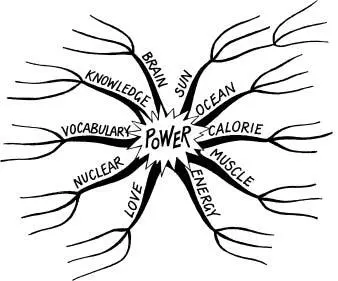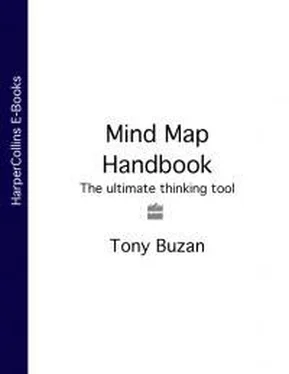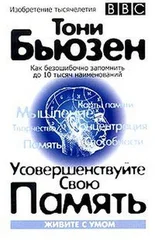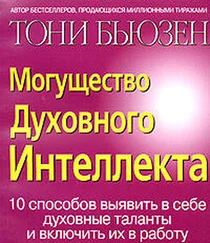Can we demonstrate this? Yes!
Here, you will find the word ‘Power’ in the centre of a page, with 10 branches radiating from it. As fast as you can, print, clearly, on the lines, the first 10 words that come into your mind when you think of the word ‘Power’. If you have friends or family with you, get them to do the same exercise, but separately from you. You do not want anybody to see what the others have done until everyone has completed the exercise. Do this now, and then read on.
I have completed the same exercise here. Check your own words against mine, seeing how many are identical (i.e., the same meaning, and exactly the same spelling).

If you are doing this exercise with friends, take it in turn to read your words out to the others. As each person reads, the others note down all the words, each person therefore ending up with the entire collection. See how many words are common to all of you, or to any sub-group of you.
In 999 cases out of 1,000, there are very few words in common.
What does this mean? It means that your vocabulary is much more expansive than you previously thought, that your ability to make associations is potentially infinite (you could have added 10 additional associations to every one of your 10 prime ordinals, couldn’t you? And so on!)
It further means that your own associations are unique, and that your ability to grow your vocabulary and enhance your Verbal Intelligence is infinite .
Memory and Verbal Intelligence – Recall During Learning
Research from the time of Hermann Ebbinghaus and William James at the end of the 19th century, to the current work of Professor Guttmann of Vienna University and myself, has confirmed that the patterns of memory are stable, predictable and, most importantly, manageable . Research has confirmed that while you are learning, you will remember more the following things:
The beginning of the learning period (the Primacy Effect)
The end of the learning period (the Recency Effect)
Anything that stands out in your imagination
Anything that you associate with something else
Memory – Recall After Learning
Again, research has consistently confirmed the same findings about what happens to your recall after you have finished learning something (some people call this ‘forgetting’!).
Case Study – Translate and Beware!
The multi-faceted wonder of words can often lead to hilarious mistranslations or misunderstandings. A recent issue of New Scientist magazine reported some wonderful bloopers:
One reader reported that the radio station The Voice of America, used to transmit western news and propaganda to the Soviet Bloc. They would then listen to the various countries’ re-translations of their transmissions. One news item reported the death of a former tennis champion, who died at her home in Tooting, London. Bulgarian radio broadcast the fact that she had: ‘Died at her home in London, playing her trumpet!’
Another reader reported the story of a computer-translated Russian technical article, converted into English. The confused engineers reading it could not make sense of the frequently recurring references to ‘water goats’. After a lot of thinking, the solution dawned: ‘water goats’ were ‘hydraulic rams’!
This last story is reminiscent of one of the oldest translation/re-translation stories, also from Russian to English. ‘Out of sight, out of mind’ was reborn as ‘invisible idiot’!

There is a simple formula to keep your memory sharp rather than letting it drop off calamitously. The first part of the formula is Repetition . You must repeat something at least five times for it to sink into your long-term memory. The second part is the timing or spacing of those five repetitions. Your repetitions, or reviews, should be spaced out roughly according to the following formula:
First repetition – after one hour
Second repetition – after one day
Third repetition – after one week
Fourth repetition – after one month
Fifth repetition – after six months
Following this formula for your Verbal Intelligence studies will make the difference between complete success and absolute failure.
Your Left and Right Brain
Less than 20 years ago, most people had never heard of the left/right brain research. Now, fortunately, it has become part of global knowledge.
To summarize briefly: the left side of your brain deals predominantly with words, logic, numbers, sequence, linearity, analysis and lists. The right side of your brain deals predominantly with rhythm, spatial awareness, dimension, imagination, daydreaming, colour and holistic awareness.
You will see that words are designated to belong on the left side of the brain. This, however, is not the final picture. For people with high Verbal Intelligences, brainwave measurements show that when they are presented with words the whole cortex lights up. In other words, words are everywhere! This is especially true of poets, writers and Grandmasters of Memory.
The reason their entire brains light up is because they realize that words are not simply words. Words are the word itself plus the imaginative, colourful, rhythmical and spatial associations that are part of the full meaning of that word!
Mind Maps
Mind Maps are perfect examples of the above principle.
They are an explosion of the multi-ordinate nature of words exercise you did with ‘Power’. Their key is that any word or image can be placed in the centre of the page, and can radiate out infinitely.
Mind Maps are also an exact reflection of the Recall During Learning principles of Association and Imagination. Indeed you could describe a Mind Map as an associative network of images ( imagination ) and words.
Further, Mind Maps incorporate all the elements of your left and right brain, giving you the added power of the synergy between the two sides (the 1 + 1 = more than 2 principle).
By using Mind Maps you vastly enhance your Verbal Intelligence. There are colourful examples of Mind Maps in the plate section.
Verbal Workout
Word Puzzle Number 9
1. hacyt
__ X __ __ __
2. volen
X X __ __ __
3. ryemom
__ __ __ XX __
4. ziliode
__ X __ X __ __ X
Clue: Brain of the millennium. __ __ __ __ __ __ __ __
Verbal Intelligence Tip
Look at the jumbled letters in ‘soft focus’.
Why?
Because soft focus once again allows your para-conscious brain to work on the problem.
Soft focus is when you ‘let your eyes go’, much as if you are too tired to focus, or as if you are ‘looking beyond’ the letters in front of you. When you do this the letters become a little bit fuzzy (you are literally using ‘fuzzy logic’ here!) and tend to shift or wobble about in your visual field. This gets them out of the rigid order that they are in on the page, and allows your brain to play around with them much more freely. Because this is happening, you are much more likely to have the answer ‘pop up’. This is also because your brain, scanning the way in which the fuzzy images are appearing, can more easily see appropriate patterns of letters as they shift around in front of your eyes.
It is a paradoxical situation, worth giving some thought to, that in this instance clarity keeps you farther away from the correct answer, while fuzziness gives you clarity!
Читать дальше














